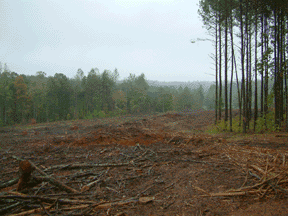| Sustainable Harvest Practices |
|
There are essentially two broad categories of forest harvests; those done purely for commercial purposes without regard to future growth and forest development, and those done to promote a sustainable forest. It is crucial that landowners recognize this difference and understand the impacts each of these harvests will have on their forest both now and into the future. When the decision is made to harvest a forest, a forester is immediately interested in regeneration and the steps that will be taken to insure that a high quality young forest is set to replace the older forest that is harvested. Here is where silviculture really gets interesting. Foresters will consider a whole host of factors, such as tree species, tree value and markets, availability of loggers and equipment, desires of the forest owner, quality of the site, and others, to select an appropriate method of regeneration. To a forester, what is left on the site is much more important than what is removed from the site. |
||
 |
Sustainable harvest practices are those which take into consideration regeneration and the long-term well-being of the forest. In a sustainable harvest either the best trees will be left standing until a new forest of younger, healthy trees begins to grow underneath it, or everything will be removed so there is no vegetation left to compete with the young sprouts and seedlings. In the second type of harvest mentioned (a silvicultural clearcut) new trees can be planted in this open area, or the healthiest young growth (the seeds and sprouts already on the ground) will be able to outcompete the weaker individuals, and the forest will begin to form itself into a healthy future stand. | |
| It is difficult to understand how a clearcut, which removes all of the trees from a stand, can be better for the forest than a "commercial clearcut" which leaves a number of smaller trees growing. The key factor is that the trees which are left in the "commercial" harvest are often slow-growing trees with poor structure and undesirable species. This promotes a future forest composed of trees which come from the weakest possible parents. Some people may argue that if the forest will never be harvested again, it is irrelevent whether the trees are come from the best, fastest-growing parents, but the ability to resist diseases, insects, and other causes of damage is directly linked to the health and vitality of the individual trees. |  |
|
|
Unfortunately, many people choose to perform commercial clearcuts, commonly referred to as high-grading. This type of forest harvest will provide the most money, typically, but the cost is much higher when the long-term growth of the forest is considered. Any future stand will take much longer to grow and won't have the same quality of trees as the previous harvest. It is important to point out that sustainable harvests are also "commercial", though they typically yield less money per acre in the short term. However, over the long term, sustainable harvests will produce more income because higher quality trees will bring more value. Forestry is a long term enterprise. |
||